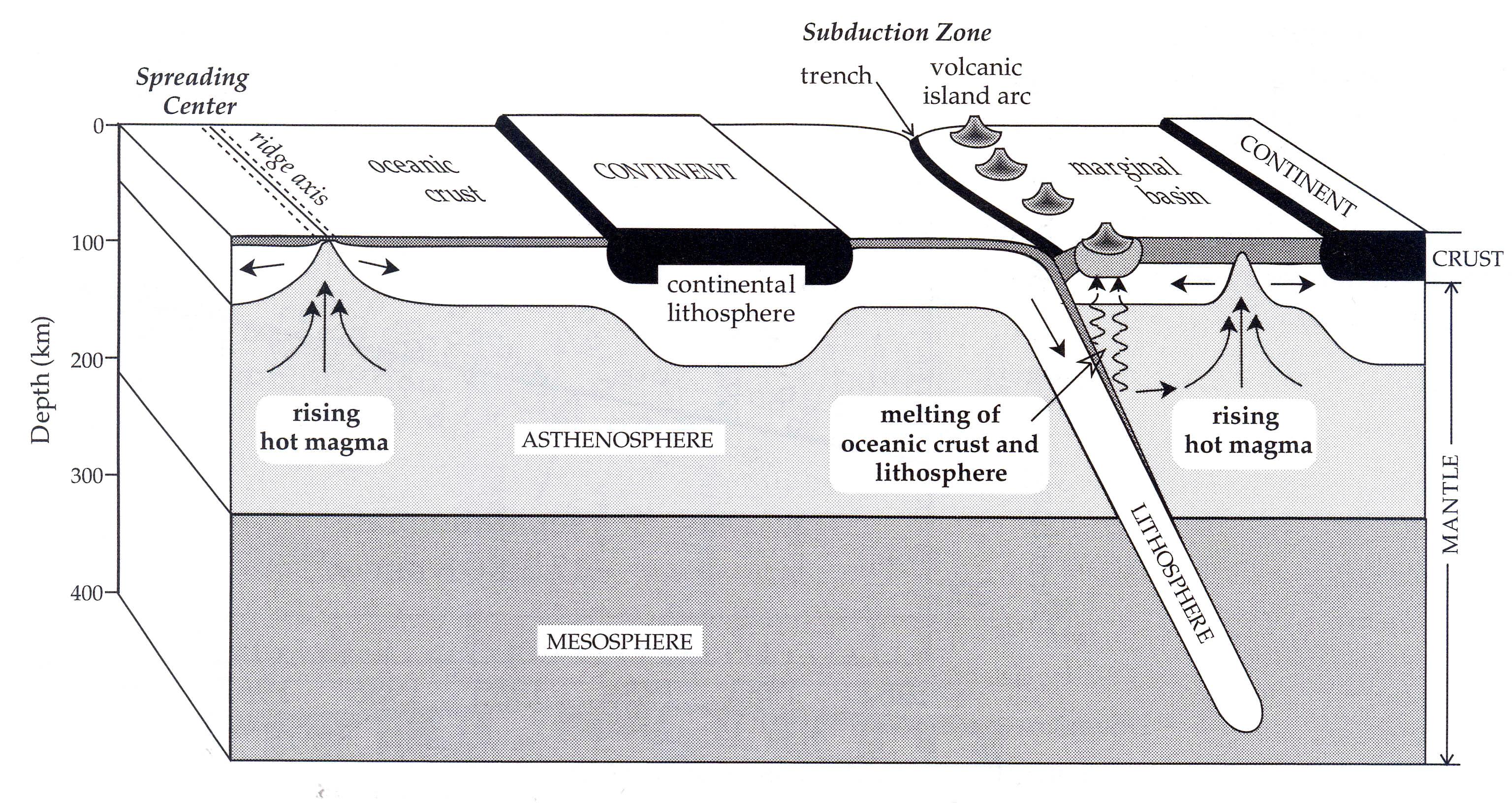
1.2.6 Plate margins
It is important to keep in mind that the tectonic plates are not crustal units. They involve the entire thickness of the lithosphere, of which the crust is only the outer skin. Oceanic lithosphere is thin close to a ridge axis, but thickens with distance from the ridge, reaching a value of 80-100 km; the oceanic crust makes up only the top 5-10 km. Continental lithosphere may be up to 150 km thick, of which only the top 30-60 km is continental crust. Driven by mechanisms that are not completely understood, the lithospheric plates move relative to each other across the surface of the globe. This knowledge supplies the "missing link" in Wegener's continental drift hypothesis, removing one of the most serious objections to it. It is not necessary for the continents to plow through the rigid ocean basins; they are transported passively on top of the moving plates, as logs float on a stream. Continental drift is thus a consequence of plate motions.
The plate tectonic model involves the formation of new lithosphere at a ridge and its destruction at a subduction zone (Fig. 1.17). Since the mean density of oceanic lithosphere exceeds that of continental lithosphere, oceanic lithosphere can be subducted under continental or oceanic lithosphere, whereas continental lithosphere cannot under-ride oceanic lithosphere. Just as logs pile up where a stream dives under a surface obstacle, a continent that is transported into a subduction zone collides with the deep-sea trench, island arc or adjacent continent. Such a collision results in an orogenic belt. In a continent-continent collision, neither plate can easily subduct, so relative plate motion may come to a halt. Alternatively, subduction may start at a new location behind one of the continents, leaving a mountain chain as evidence of the suture zone between the original colliding continents. The Alpine-Himalayan and Appalachian mountain chains are thought to have formed by this mechanism, the former in Tertiary times, the latter in several stages during the Paleozoic. Plate tectonic theory is supported convincingly by an abundance of geophysical, petrological and geological evidence from the three types of plate margin. A brief summary of the main geophysical observations at these plate margins is given in the following sections. Later chapters give more detailed treatments of the gravity (Section 2.6.4), seismicity (Sections 3.5.3 and 3.5.4), geothermal (Section 4.2.5) and magnetic (Section 5.7.3) evidence.

Fig. 1.17 Hypothetical vertical cross-section through a lithospheric plate from a spreading center to a subduction zone.
1.2.6.1 Constructive margins
Although the ridges and rises are generally not centrally located in the ocean basins, they are often referred to as mid-ocean ridges. The type of oceanic basalt that is produced at an oceanic spreading center is even called a mid-ocean ridge basalt (MORB for short). Topographically, slow-spreading ridges have a distinct axial rift valley, which, for reasons that are not understood, is missing on faster-spreading ridges. Partially molten upper mantle rocks (generally assumed to be peri-dotites) from the asthenosphere rise under the ridges. The decrease in pressure due to the changing depth causes further melting and the formation of basaltic magma. Their chemical compositions and the concentrations of long-lived radioactive isotopes suggest that MORB lavas are derived by fractionation (i.e., separation of components, perhaps by precipitation or crystallization) from the upwelling peridotitic mush. Differentiation is thought to take place at about the depth of the lower crustal gabbroic layer beneath the ridge in a small, narrow magma chamber. Some of the fluid magma extrudes near the central rift or ridge axis and flows as lava across the ocean floor; part is intruded as dikes and sills into the thin oceanic crust. The Vine-Matthews-Morley hypothesis for the origin of oceanic magnetic anomalies requires fairly sharp boundaries between alternately magnetized blocks of oceanic crust. This implies that the zone of dike injection is narrow and close to the ridge axis.
The distribution of earthquakes defines a narrow band of seismic activity close to the crest of an oceanic ridge. These earthquakes occur at shallow depths of a few kilometers and are mostly small; magnitudes of 6 or greater are rare. The seismic energy released at ridges is an insignificant part of the world-wide annual release. Analyses show that the earthquakes are associated with normal faulting, implying extension away from the ridge axis (see Section 3.5.4).
Heat flow in the oceans is highest at the ocean ridges and decreases systematically with distance away from theridge. The thermal data conform to the model of sea-floor spreading. High axial values are caused by the formation of new lithosphere from the hot uprising magma at the ridge axis. The associated volcanism on the floor of the axial rift zones has been observed directly from deep-diving submersibles. With time, the lithosphere spreads away from the ridge and gradually cools, so that the heat outflow diminishes with increasing age or distance from the ridge.
Oceanic crust is thin, so the high-density mantle rocks occur at shallower depths than under the continents. This causes a general increase of the Earth's gravity field over the oceans, giving positive gravity anomalies. However, over the ridge systems gravity decreases toward the axis so that a "negative" anomaly is superposed on the normally positive oceanic gravity anomaly. The effect is due to the local density structure under the ridge. It has been interpreted in terms of anomalous mantle material with density slightly less than normal. The density is low because of the different mantle composition under the ridges and its high temperature.
The interpretation of magnetic anomalies formed by sea-floor spreading at constructive margins has already been discussed. The results provide direct estimates of the mean rates of plate motions over geological time intervals.
